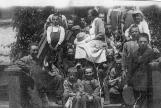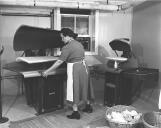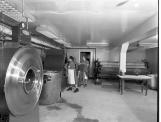1
In the post-territorial years, the walls of the Wolseley courthouse held the social, political, and economic frameworks of new institutions that allowed the town to flourish. There is perhaps no greater testament to the importance of the institutions established in part by the Champions of Justice in the North-West Territories than the versatile nature of the courthouse building in the post-territorial years.2
"Estalbish Jail Wolseley in Old Court House." Article in The Morning Leader, January 10, 191410 January 1914
 Credits:
Credits:SAB. Morning Leader. January 10, 1914.
3
After its closure in 1909, the courthouse was converted to a jail, housing fifty prisoners between 1914 and 1915. This decision was an attempt to "relieve the overcrowding in the prisons at Regina, Prince Albert, and Moosomin", which brought the judiciary back to Wolseley for a short period, as the town saw the appointment of a jailer, keeper, and a number of turnkeys to staff the building.4
Jean Chatterson with the boys at the Boys Detention Homecirca 1914-1920
Wolseley, Saskatchewan
 Credits:
Credits:Dorothy Chatterson
5
Although the courthouse stopped being used as a jail on 30 April 1915, it was transformed into a "Detention Home for boys" on 14 May 1915. A wooden addition was built, which housed approximately twenty-five boys. J.M. Smith, Deputy Minister of Public Works, wrote in the 1914 - 1915 Annual Report of the Department of Public Works that "with the instruction given, both mentally and physically, it is hoped to turn out a class of boys useful to the province and a credit to the school." The purpose of establishing such a home in Wolseley at the time was to raise boys who would be of a benefit to the province and its institutions.6
Mrs. Hedley, matron of the Boys Detention Home, with Harvey, Bruce, and Nora Chattersoncirca 1914-1920
Wolseley, Saskatchewan
 Credits:
Credits:Dorothy Chatterson.
7
Jean Chatterson in front of the court housecirca 1914-1920
Wolseley, Saskatchewan
 Credits:
Credits:Dorothy Chatterson.
8
In the fall of 1920, construction began on an extensive addition to the east wall of the courthouse, which, with the closure of the detention home in 1921, would eventually become a "Home for the Aged and the Infirm". Initially, the home had 26 patients. However, by 1944, the number of patients had reached well over 100.After a series of name changes, the nursing home became known as Lakeside Home in 1971, a name that has remained to this day. In 1982, the courthouse was designated a Provincial Heritage Property , thus saving it from demolition in 1986 when the addition was removed to make room for a modern nursing facility.
11
The demolition of the addition to the courthouse transformed the building, allowing its use for live theatre productions. In the summer of 1989, a drama troupe staged "Nistitium" by Saskatchewan playwright Archie Crail, a play based on the events leading up to the arrest of Moise Racette and James Gaddy. The play has historical connections to the judicial system in Wolseley being a dramatization of one of the town's most famous stories. The play's run, however, was only temporary, as the result of a grant application made by the Wolseley and District Chamber of Commerce. Nistitium was deemed an "overwhelming success", employing local high school students with meaningful summer employment, and involving notable theatre technicians from Regina.By staging "Nistitium" in the court house, the people involved paid tribute to the institutions upon which the country was built. The play's connection to the judicial system brought the building back full circle to the judicial foundation laid by the Champions of Justice Chief Justice Edward Wetmore, Sir Frederick Haultain, and Levi Thomson.
12
Woman doing laundry in the basement of the courthouse1955
Wolseley, Saskatchewan
 Credits:
Credits:SAB. R-A11412-2.

